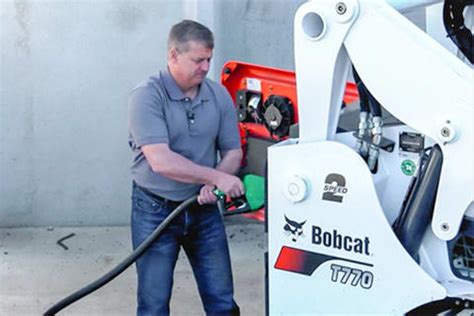check skid steer fluid Each attachment requires different levels of fluid, so always check the operator’s . Browse 306 authentic mini excavator stock photos, high-res images, and pictures, or explore additional mini excavator garden or mini excavator service stock images to find the right photo at the right size and resolution for your project.
0 · fluid on bobcat
1 · bobcat track loader fluid level
2 · bobcat skid steer hydraulic level
3 · bobcat skid steer fluid level
4 · bobcat skid steer fluid check
5 · bobcat hydraulic fluid level
Remove the Dipstick and Check the Oil Level. Pull the cleaned dipstick out of the pump or reservoir (do not drop it!). There will be two marks on it: high and low marks. The oil level of your hydraulic excavator should be .
Is it time to check or change the chaincase (aka final drive transmission) fluid in your skid-steer loader? Watch this video to learn how to complete the procedure.
Checking the hydraulic fluid level on your Bobcat skid steer or track loader is simple and quick. There are three possible methods, depending on the model. O. Each attachment requires different levels of fluid, so always check the operator’s .
Is it time to check or change the chaincase (aka final drive transmission) fluid in your skid-steer loader? Watch this video to learn how to complete the procedure. Checking the hydraulic fluid level on your Bobcat skid steer or track loader is simple and quick. There are three possible methods, depending on the model. O.
Each attachment requires different levels of fluid, so always check the operator’s manual for the correct type of fluid and the necessary level. Start the skid steer engine and slowly operate the grapple controls. This step circulates the fluid and removes any air trapped in the system. Continue to operate the controls until the grapple moves . 1. Locate the Hydraulic Fluid Reservoir. 2. Clean the Reservoir Cap and Surrounding Area. 3. Remove the Reservoir Cap. 4. Check the Fluid Level. 5. Inspect the Fluid Condition. 6. Add Fluid if Necessary. 7. Replace the Reservoir Cap. Troubleshooting Fluid Issues. Cloudy or Foamy Fluid. Black or Discolored Fluid. Burning Smell. 213. 82K views 3 years ago. The chaincase (aka final drive transmission) contains the final drive sprockets and chains that drive the wheels. As the chains and sprockets wear, the fluid becomes. Every day before you operate your Cat® Skid Steer Loader you need to check your fluids. It's important not to introduce contaminants as you do so. Caterpilla.
There are three possible methods of checking the hydraulic fluid level on your Bobcat skid steer or track loader, depending on the Bobcat model. They're all simple and quick, as Randy demonstrates in this video.
The greatest performance comes with the greatest care and that‘s why we advise you to check your skid-steer loaders daily. We have created instructional videos, so you can make sure that everything is in order so you will be able to execute even the . Changing hydraulic fluid in New Holland skid steers is a crucial maintenance procedure that ensures optimal performance and longevity of your equipment. Insert a funnel into the hydraulic reservoir and slowly pour in the new Holland-approved hydraulic fluid. Check the Hydraulic Fluid Level. If it’s not already part of your daily preparation, add checking the hydraulic fluid to your list. This is a simple task that can provide a lot of insight. Ensure there is enough fluid. If there’s not, it can cause severe damage to your pumps.
Is it time to check or change the chaincase (aka final drive transmission) fluid in your skid-steer loader? Watch this video to learn how to complete the procedure.
Checking the hydraulic fluid level on your Bobcat skid steer or track loader is simple and quick. There are three possible methods, depending on the model. O. Each attachment requires different levels of fluid, so always check the operator’s manual for the correct type of fluid and the necessary level. Start the skid steer engine and slowly operate the grapple controls. This step circulates the fluid and removes any air trapped in the system. Continue to operate the controls until the grapple moves . 1. Locate the Hydraulic Fluid Reservoir. 2. Clean the Reservoir Cap and Surrounding Area. 3. Remove the Reservoir Cap. 4. Check the Fluid Level. 5. Inspect the Fluid Condition. 6. Add Fluid if Necessary. 7. Replace the Reservoir Cap. Troubleshooting Fluid Issues. Cloudy or Foamy Fluid. Black or Discolored Fluid. Burning Smell. 213. 82K views 3 years ago. The chaincase (aka final drive transmission) contains the final drive sprockets and chains that drive the wheels. As the chains and sprockets wear, the fluid becomes.
Every day before you operate your Cat® Skid Steer Loader you need to check your fluids. It's important not to introduce contaminants as you do so. Caterpilla. There are three possible methods of checking the hydraulic fluid level on your Bobcat skid steer or track loader, depending on the Bobcat model. They're all simple and quick, as Randy demonstrates in this video.The greatest performance comes with the greatest care and that‘s why we advise you to check your skid-steer loaders daily. We have created instructional videos, so you can make sure that everything is in order so you will be able to execute even the .
used bobcat skid steer for sale in florida
Changing hydraulic fluid in New Holland skid steers is a crucial maintenance procedure that ensures optimal performance and longevity of your equipment. Insert a funnel into the hydraulic reservoir and slowly pour in the new Holland-approved hydraulic fluid.

fluid on bobcat

cat 420d: standing at rear, behind the left rear tire and inner fender/frame wall. uses a 13 or 15 mm wrench to loosen safety lock. cat 320c and other excavators: standing at .
check skid steer fluid|bobcat skid steer hydraulic level